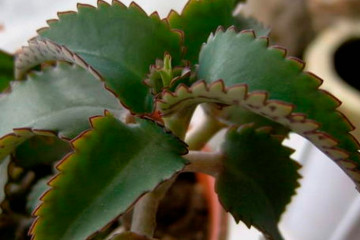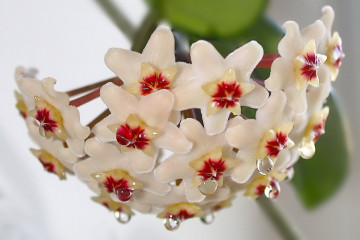Chlorophytum pests and diseases - causes and fight
Content:
Chlorophytum (chlorophytum) is a perennial herb from the Asparagus family with narrow green leaves and tendrils. Despite his resistance to most diseases, he can still sometimes suffer from some of them. Further information on the most common diseases of chlorophytum and methods of treatment.
Why a plant can get sick
Incorrect conditions of detention or lack of immunity can lead to the appearance of diseases in a flower. Both insufficient and excessive care can harm the plant.
Common causes of diseases:
- waterlogging of the soil;
- insufficient lighting;
- low indoor humidity;
- sunburn;
- excess of minerals in the soil;
- mechanical damage to the root system;
- lack of nutrients;
- cramped pot and heavy soil;
- wrong temperature conditions.
The culture absorbs carbon dioxide and other harmful impurities in the air, while releasing phytoncides - substances that kill pathogenic bacteria. For cultivation, choose chlorophytum Crested, Cape, Winged or Curly.
Drops the leaves
The plant may suffer from shedding of leaves. The appearance of a mealybug on the flower can lead to this.
At first, the foliage will wither and then discard. Also, the plant will face poor development and growth retardation. In the worst case, chlorophytum will die if you do not take measures to combat the pest. You can identify the infection by the secretions of the mealybug on the leaves - a white bloom that resembles cotton wool.
At the first sign of infection, you should use a swab soaked in soapy water. They need to rub the leaves. Cleaning is needed for hard-to-reach places - leaf sinuses.
Also, for preventive purposes, you can use a green soap solution intended for spraying. You need to process the plant at intervals of a week.
Special preparations will help to cope with the pest itself:
- Aktar;
- Calypso;
- Biotlin.
Each drug will be accompanied by a user guide. You need to treat the plant with one of the medicines for 7-14 days.
The shedding of leaves can also begin because of the scale insects that have settled on the leaves and in their petioles. Before shedding, the foliage will fade and lose its luster. These insects damage the skin of the leaves and drink the sap of the plant.
The presence of scale insects is evidenced by sticky secretions on the leaves, leading to the rapid development of a sooty fungus. This will negatively affect the photosynthesis of the plant and subsequently cause the death of the flower.
Wipe the leaves with alcohol, and after spraying with Karbofos or Actellik, will help get rid of the scale insects.
Chlorophytum - home care: leaves turn yellow, what to do
The plant may lose its decorative color, and its crown may become pale. It's all to blame for poor and insufficient lighting. This light-loving culture needs diffused sunlight. After a slight blanching of the crown, you should move the flower to the windowsill. Additionally, you can use artificial lighting for the plant.
If the foliage of the plant has begun to turn pale, then you need:
- Moisten the soil well.
- Feed the flower with special fertilizers for indoor plants.
- Move the flower pot to a bright place.
Many also care about why the leaves of chlorophytum turn yellow when leaving at home and what to do in this case. This can happen not only due to some kind of disease.
Most often, chlorophytum leaves turn yellow and dark spots appear due to improper maintenance conditions. Causes of yellowing include:
- lack of moisture or its excess;
- mechanical damage to the plant;
- lack of nutrients;
- natural old age;
- unsuitable pot.
If old leaves turn yellow, then there is nothing to worry about. You just need to get rid of them. Broken foliage indicates nutritional deficiencies. In this case, the damaged areas are removed, and the plant itself is fed. If the reason for the yellowing is a small pot, then it is changed to a more spacious one.
Leaves or tips dry, curl and wrinkle
Not everyone knows why the tips of the leaves dry out in chlorophytum. This can begin due to a lack of nutrients in the soil, excess salts, frequent application of urea, skipping irrigation, moistening with unsettled hard water.
Transplanting the plant into a pot with new soil will help correct the situation. Correct, timely watering and fertilization will correct the fact that the tips of the leaves of chlorophytum dry out.
Leaves or their ends are prone to curling and wrinkling. This can lead to a lack of magnesium, fluoride and potassium in old leaves and molybdenum, copper and magnesium in young ones. Also, the leaves curl, wrinkle and can dry out due to:
- watering with water from the water supply;
- drying out or flooding of the soil;
- pest attacks;
- too dry air at home;
- excess fertilizer.
You can cure a flower by following the rules for care.
Rotting roots, leaves, shriveled trunk
Roots can rot and die due to excess moisture and heavy soil. This is usually encountered in the winter season. Root rot becomes more visible when it reaches the aerial part of the plant. After that, the leaves may turn yellow and become stained. They will eventually turn black and rot too.
If the disease reaches the surface, the trunk is black, and the leaves begin to darken, then the affected bush can no longer be saved. In this case, only cuttings will help. Chlorophytum cannot be left intact; it is useless to treat it in this state.
The trunk of a plant may wrinkle due to drying out of the earth or insufficient lighting, in this case chlorophytum does not grow. This does not occur due to the attack of pests. This phenomenon is considered dangerous for the flower.
Pests
The main reason why chlorophytum does not shoot arrows is the presence of pests. If you start to fight them in time, then the flower will recover. In addition to the mealybug and scale insects, the plant can be attacked by:
- Aphid. Symptoms are curling and drying of the leaves. For the fight, the drug Actellik is suitable.
- Nematode. Signs - growth retardation, twisting foliage, round growths on the roots. The best way to get rid of it is heat treatment.
- Spider mite. Manifestations are a thin web between leaves and stem.Treatment of the plant with Actellik will help.
Lovers of indoor flowers must have information about the diseases and pests of chlorophytum. Then they will be able to competently care for the flower and will not lose the plant.



















